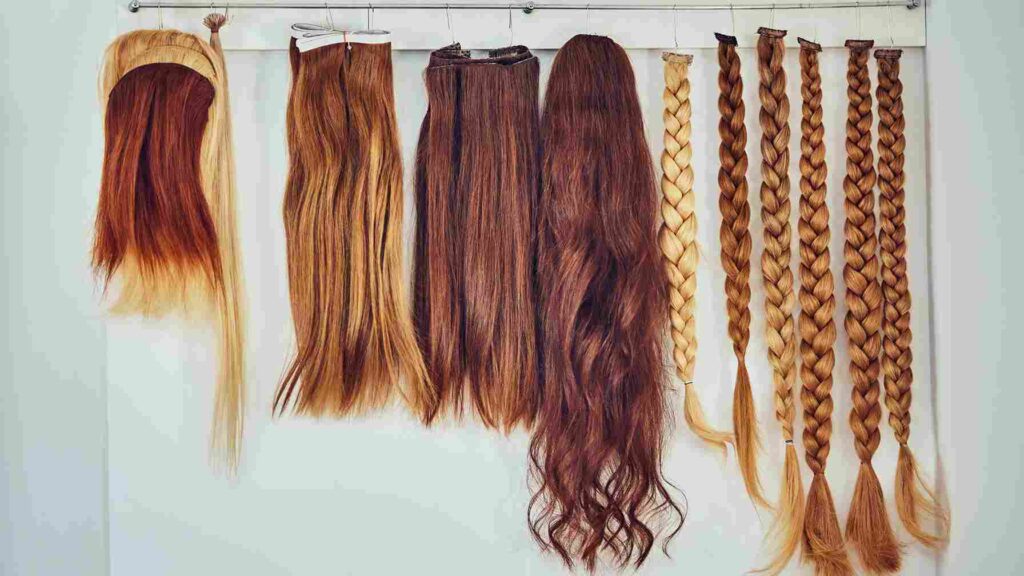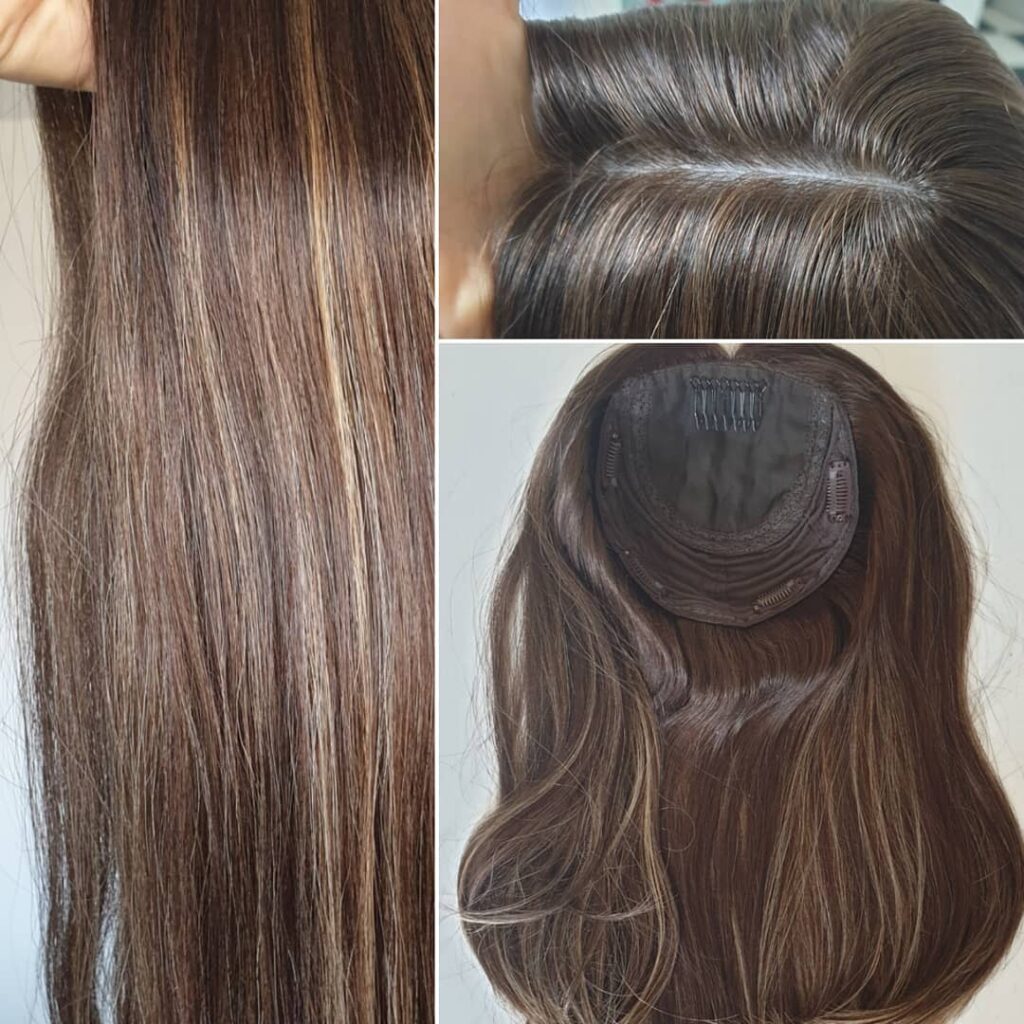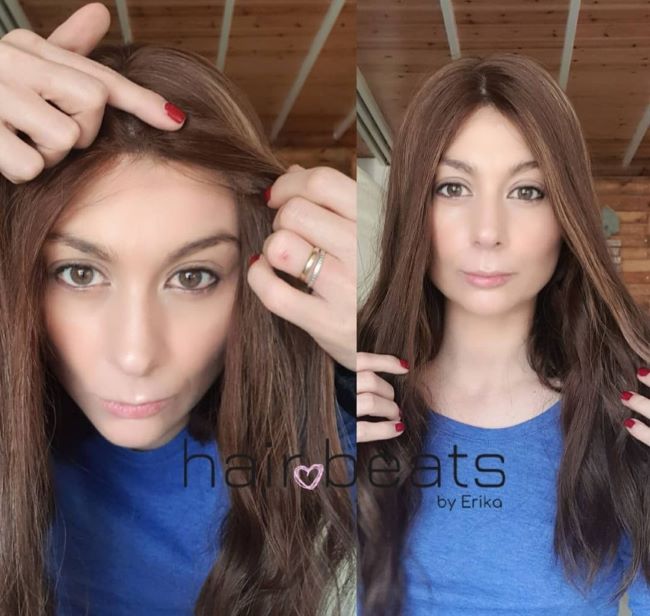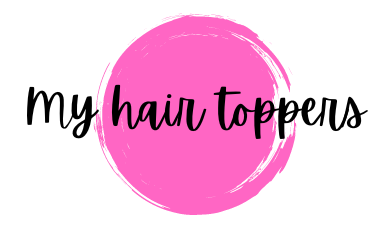Do Clip In Hairpieces & Toppers Damage Your Hair?
7 Best Practices to Avoid Bio Hair Damage

If you’re venturing into the world of clip in hairpieces like, for example, hair toppers, you’ll want to follow these best practices to ensure the health of your natural hair. As someone who has experienced hair thinning and tried various toppers, I can attest to the importance of these tips.
1. Hair Toppers For Women: Choose a Larger Base
When picking a hair topper, go for a larger base than you initially think you require. Many people opt for smaller bases, thinking they only need to cover a specific area. However, a larger base offers several advantages.
A larger base distributes the weight of the topper more evenly, making it more comfortable to wear. When you clip a topper near the thinning area with a small base, each clip exerts more pressure on individual hair strands, potentially leading to damage. In contrast, a larger base allows clips to grab more hair, reducing the strain on each strand. This also means less movement and shifting, making it easier to blend.
While a larger base might mean more hair, it’s a small trade-off for the comfort and reduced damage it offers.

2. Clip-In Hairpieces Extensions & Traction Alopecia
Traction alopecia can be a concern with clip-in hair extensions if not installed correctly. To minimize the risk:
Avoid Close Roots: Ensure you don’t attach the extensions too close to your hair roots, giving your natural hair room to breathe.
No Overnight Wear: Remove clip-ins before bedtime to prevent tension and potential damage while sleeping.
Moderation is Key: Don’t overdo it by adding too many wefts. Keep it moderate to reduce stress on your hair.
Consider Lighter Extensions: Opt for lighter and shorter extensions if you plan to wear them frequently. Lighter extensions put less strain on your hair, minimizing the risk of traction alopecia.
3. Only Style Your Clip in Hairpieces and Hair Toppers on a Mannequin Head
To protect your bio hair from damage, never style your clip in hairpieces or toppers while it’s attached to your head. Blow-drying or styling it on your scalp can cause undue stress on your natural hair, resulting in breakage, discomfort, and shifting.
Invest in a cork or styrofoam mannequin head, and use T-pins or a clamp to secure your topper or clip in hairpieces while styling. This way, you can style your topper without any pulling or tugging on your bio hair.
4. Grab as Much Hair as Possible in the Clips
When you’re attaching your hairpiece, aim to clip in as much hair as you can. This is particularly beneficial if you have more hair to work with. If you have a hair topper, clipping it lower, where you typically have more hair, ensures a more comfortable fit.
If you feel any pulling or discomfort from the clips, consider relocating them to areas with more hair. Alternatively, swap out the clips for those with long teeth, which tend to grab more hair securely. Replacing clips can be a simple but effective way to minimize hair damage.
5. Consider a Lace Front Topper
If you have thinning hair along the front hairline and you are considering a clip in hair topper, consider a lace front topper. A lace front topper allows you to cut it close to your hairline and secure it using tape or glue. This eliminates the need for clips or combs at the front, reducing the risk of damage.

6. Use a Topper Grip
A topper grip is an excellent accessory to prevent damage, especially if you have a smaller cap. It sits on top of your head, and your hair is pulled over it. You can clip the topper’s front clip or comb into the grip. While it may lift the topper slightly, it significantly reduces pressure on your hair, minimizing the risk of damage.
7. Teasing The Area Where The Clip Are Attached
Dry Shampoo and any other texturizing product can help create “ticker strands” This trick gives the area where you attach the clips more “grip”.
Dry Shampoo and Texturizing Products: Dry shampoo and similar products can be applied to your natural hair before attaching clip-in extensions. These products add texture and volume to your hair, creating the illusion of thicker strands. This added texture helps the clips of the extensions hold onto your hair more securely because they have better “grip” on the textured hair.
Backcombing: If you intend to backcomb (tease) your natural hair to create more volume or texture, you should do it carefully. Backcombing involves combing hair against its natural direction, creating tangles and knots that add volume. However, excessive or aggressive backcombing can lead to hair damage or breakage. So, the advice is to be cautious when backcombing to avoid harming your hair.
